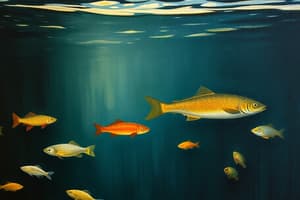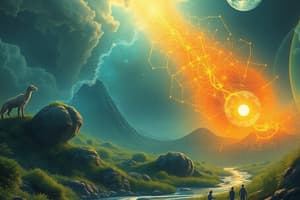Podcast
Questions and Answers
What is the role of abiotic and biotic factors in ecosystem ecology?
What is the role of abiotic and biotic factors in ecosystem ecology?
Abiotic and biotic factors play a significant role in ecosystem ecology by influencing the components, structures, and ecosystem processes.
What is the primary source of energy for life in ecosystems?
What is the primary source of energy for life in ecosystems?
- Wind energy
- Solar energy (correct)
- Geothermal energy
- Hydroelectric energy
Only 1-2% of solar energy entering Earth's ecosystems is utilized by the food chains.
Only 1-2% of solar energy entering Earth's ecosystems is utilized by the food chains.
True (A)
Entropy can be described as the degree of disorder or randomness in the _________________
Entropy can be described as the degree of disorder or randomness in the _________________
Match the trophic level with its description:
Match the trophic level with its description:
Define autotrophs and provide an example.
Define autotrophs and provide an example.
Energy from the sun passes to plants, then to ____, and finally to carnivores.
Energy from the sun passes to plants, then to ____, and finally to carnivores.
What is the primary source of energy for the biosphere?
What is the primary source of energy for the biosphere?
Energy is lost at each trophic level in an ecosystem.
Energy is lost at each trophic level in an ecosystem.
Match the following trophic levels with their corresponding roles:
Match the following trophic levels with their corresponding roles:
Flashcards are hidden until you start studying
Study Notes
Ecosystem Metabolism
- Ecosystem metabolism is the process of energy flow and material cycling in ecosystems.
- Energy from the sun passes through plants, herbivores, and carnivores, with energy lost at each level.
Energy Flow in Ecosystems
- Life represents a local increase in order (decrease in entropy) powered by energy.
- Entropy is the degree of disorder or randomness in the system.
- Ecosystems need constant input of energy to function.
Solar Radiation
- Solar radiation consists of electromagnetic waves created by hydrogen nuclei fusion in the sun.
- The sunbeam spectrum is very wide, but almost all the radiation energy is in the visible light (400-700 nm) between the ultraviolet and infrared spectrum.
Sunlight Levels
- Communities process solar energy through green plants, and the resulting energy fixed via photosynthesis sustains all trophic levels in the food web.
- Only 1-2% of solar energy hitting Earth enters ecosystems.
- Tropical regions receive 2.5 times more energy than poles.
- Poles and temperate regions have seasonal fluctuations, which affects their ecologies.
Global Energy Balance
- The Earth emits a similar amount of radiation energy into space as the atmosphere and Earth's surface absorb incoming solar radiation.
- This energy balance keeps the global average temperature to about 15 °C.
- 1-2% of the spectrum (especially the red and blue light) is utilized by green plants for photosynthesis.
Trophic Level and Food Chains
- Trophic level: A feeding level in an ecosystem.
- Trophic: relating to feeding and nutrition.
- Organisms located at the same step in relation to the food source are on the same trophic level.
- The transfer of energy from plants to animals is done through several links called a food chain.
Modes of Nutrition
- Autotrophs use solar energy and materials from nonliving sources.
- Heterotrophs pick up energy and materials by eating living matter.
- Herbivores are heterotrophs that eat plants.
- Carnivores are heterotrophs that eat other heterotrophs.
- Heterotrophs are either consumers (herbivores, carnivores, and scavengers) or decomposers (saprophytes and detritivores).
Trophic Levels
- Levels of producers/consumers are trophic levels.
- First trophic level: producers – Autotrophs.
- Second trophic level: Primary consumers – Herbivores.
- Third trophic level: Secondary consumers – Carnivores (mesopredators).
- Fourth trophic level: Tertiary consumers – Top level carnivores (apex predators).
- Omnivores eat at many levels.
Food Chain
- Food chain is the linear unidirectional flow of energy and materials through the food from one trophic level to the other.
- In a food chain, each stage represents a trophic level.
- Food chains are interconnected.
- Animals of successive trophic levels in a food chain tend to be larger.
Ecosystem Metabolism
- Ecosystem metabolism is the process of energy flow and material cycling in ecosystems.
- Energy from the sun passes through plants, herbivores, and carnivores, with energy lost at each level.
Energy Flow in Ecosystems
- Life represents a local increase in order (decrease in entropy) powered by energy.
- Entropy is the degree of disorder or randomness in the system.
- Ecosystems need constant input of energy to function.
Solar Radiation
- Solar radiation consists of electromagnetic waves created by hydrogen nuclei fusion in the sun.
- The sunbeam spectrum is very wide, but almost all the radiation energy is in the visible light (400-700 nm) between the ultraviolet and infrared spectrum.
Sunlight Levels
- Communities process solar energy through green plants, and the resulting energy fixed via photosynthesis sustains all trophic levels in the food web.
- Only 1-2% of solar energy hitting Earth enters ecosystems.
- Tropical regions receive 2.5 times more energy than poles.
- Poles and temperate regions have seasonal fluctuations, which affects their ecologies.
Global Energy Balance
- The Earth emits a similar amount of radiation energy into space as the atmosphere and Earth's surface absorb incoming solar radiation.
- This energy balance keeps the global average temperature to about 15 °C.
- 1-2% of the spectrum (especially the red and blue light) is utilized by green plants for photosynthesis.
Trophic Level and Food Chains
- Trophic level: A feeding level in an ecosystem.
- Trophic: relating to feeding and nutrition.
- Organisms located at the same step in relation to the food source are on the same trophic level.
- The transfer of energy from plants to animals is done through several links called a food chain.
Modes of Nutrition
- Autotrophs use solar energy and materials from nonliving sources.
- Heterotrophs pick up energy and materials by eating living matter.
- Herbivores are heterotrophs that eat plants.
- Carnivores are heterotrophs that eat other heterotrophs.
- Heterotrophs are either consumers (herbivores, carnivores, and scavengers) or decomposers (saprophytes and detritivores).
Trophic Levels
- Levels of producers/consumers are trophic levels.
- First trophic level: producers – Autotrophs.
- Second trophic level: Primary consumers – Herbivores.
- Third trophic level: Secondary consumers – Carnivores (mesopredators).
- Fourth trophic level: Tertiary consumers – Top level carnivores (apex predators).
- Omnivores eat at many levels.
Food Chain
- Food chain is the linear unidirectional flow of energy and materials through the food from one trophic level to the other.
- In a food chain, each stage represents a trophic level.
- Food chains are interconnected.
- Animals of successive trophic levels in a food chain tend to be larger.
Studying That Suits You
Use AI to generate personalized quizzes and flashcards to suit your learning preferences.




